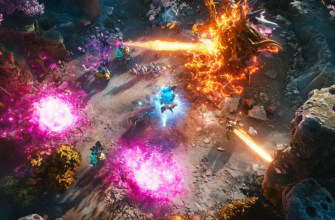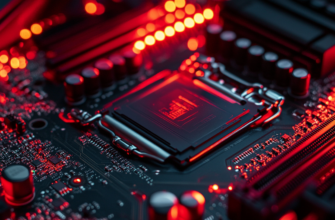- How 4K graphics have transformed the gameplay experience
- Understanding 4K graphics
- How 4K graphics alter gameplay
- 1. Visual clarity improves reaction time
- 2. Increased screen real estate in strategy games
- 3. Immersive storytelling in RPGs
- Is 4K right for you? Pros and cons of 4K gaming
- Pros of 4K gaming
- Cons of 4K gaming
- How to prepare your PC for 4K gaming
- 1. Upgrade your GPU
- 2. Invest in a 4K monitor
- 3. CPU and memory adjustments
- 4. Don’t forget about cooling!
- Tips to optimize your 4K gaming experience
- Conclusion
How 4K graphics have transformed the gameplay experience
Alright, fellow gamer, let’s talk about something that has got the entire gaming community buzzing: 4K graphics. If you’re curious about how gameplay has improved with the advent of 4K resolution, then you’re in the right place. Trust me, it’s not just about crisper textures—it’s about an entirely new level of immersion. Whether you’re plotting in an intense RPG or engaged in a fast-paced FPS, 4K resolution brings a level of detail that has reshaped how we play (and perceive) games. But to really get into it, we have to break things down step by step.
In this article, I’m going to walk you through how 4K graphics change the gameplay experience, the pros and cons, the necessary hardware upgrades, and some killer tips to enhance your gaming setup. Ready to level up? Let’s dive in!
Understanding 4K graphics
Before we go any further, let’s break down what 4K resolution means. The “4K” in 4K graphics refers to the horizontal resolution boasting approximately 4,000 pixels (often 3840 x 2160 pixels, in technical terms). This is four times the pixel count of standard 1080p (Full HD). While traditional HD can display clear graphics, 4K is like looking through a freshly cleaned glass window: everything just pops.
The difference you’re going to notice is a jump in texture fidelity, environment details, smoother edges (thanks to reduced aliasing), and even the “atmosphere” of the game. This translates directly into your gameplay. But how, exactly? Keep reading, my gaming brother (or sister), and let’s explore.
How 4K graphics alter gameplay
1. Visual clarity improves reaction time
When gaming in 4K, one of the first things you’ll notice is the enhanced attention to detail. Every little crack in a cobblestone street during an RPG, each raindrop in an action sequence, and the tiny UI elements have a new level of clarity that was missing before. It might seem like it’s just “prettier,” but 4K does more than visually impress.
Enhanced visual clarity can actually improve your reaction time in fast-paced games. Think about all the games where you need to spot enemies hiding behind a crate or catch a subtle movement in your peripherals. In 1080p or lower, small crucial details, like an enemy sniper’s glint, may go unnoticed. In 4K, however, those tiny visual cues become significantly more noticeable. It’s not just eye candy—it’s a tactical advantage.
2. Increased screen real estate in strategy games
If, like me, you enjoy games that involve strategy—think real-time strategy (RTS) or map-based strategy games—a higher resolution means more space to fit on the screen. In strategy games, you can see a larger portion of the battlefield or the intricacies of a city without constantly zooming in and out.
For example, in games like *Civilization VI* or *Total War*, the amount of information that can be displayed on a 4K screen is staggering. You’ll have a broader view of the terrain and units, allowing you to react in a much more streamlined and efficient way. It saves you from getting bogged down by micro-managing and lets you focus on higher-level decision-making.
3. Immersive storytelling in RPGs
RPGs have always thrived on immersion and world-building. When you’re playing an intricate game like *The Witcher 3* or *Cyberpunk 2077* in 4K, the level of detail helps bring you deeper into the story. Textures on character models look lifelike, from Geralt’s battle-scarred face to the vibrant neon glow of Night City. Landscapes feel endless, and every little detail helps strengthen the connection with the game world.
As I navigated through Toussaint in *The Witcher 3*, the beauty of vineyards and rolling hills in 4K hooked me like never before. Even mundane NPCs seem more alive. With higher-quality visuals, you notice intricate facial expressions, making important story moments more impactful. It’s like reading a comic book in ultra-HD—everything feels richer.
Is 4K right for you? Pros and cons of 4K gaming
Pros of 4K gaming
- Immersive experience: The graphics pull you into the game world more effectively than ever before.
- Sharper visuals: Better clarity, crisper textures, and overall cleaner image quality. Say goodbye to pixelated edges!
- Wider field of view (FoV): Especially useful in strategy or simulation games where seeing more makes a big difference.
- Better visibility: Notice smaller details, like distant enemies or subtle environment changes, which would be missed in lower resolutions.
Cons of 4K gaming
- Hardware demands: Trust me, not all PCs are built to handle 4K gaming at its best. You’re looking at needing a pretty beefy GPU (graphics card) and CPU to run newer titles smoothly in 4K without dropping your framerate to a crawl.
- Higher cost: Not just the GPU and CPU, but 4K gaming monitors or TVs can get pricey. Be ready to commit some serious cash if you want to upgrade.
- Increased file sizes: Games that support 4K textures and assets use up more storage space, potentially requiring you to buy additional SSDs to store your collection.
How to prepare your PC for 4K gaming
So, you’re ready to dive into 4K. But before you do, let’s get your rig ready. Not all hardware can handle the load that 4K puts on your system, so upgrading certain components is essential for a smooth gaming experience. Here’s a step-by-step guide on optimizing your PC for 4K.
1. Upgrade your GPU
The biggest requirement for seamless 4K gaming is the graphics card. The GPU is responsible for producing complex visuals, and when you’re pushing four times as many pixels as 1080p, that’s a major workload. GPUs like Nvidia’s RTX 3080 or AMD’s RX 6800 XT come recommended for 4K gaming. If your current GPU is below this range, consider upgrading.
2. Invest in a 4K monitor
It seems obvious, but you won’t experience 4K unless you have the right monitor. Invest in a 4K monitor with good refresh rates (minimum 60Hz, but 120Hz+ would be ideal). You’ll also want one with reasonably low response times if you play competitive games.
3. CPU and memory adjustments
While the GPU does the heavy lifting, your CPU still has to be powerful enough to keep pace. Modern multi-core CPUs, such as the AMD Ryzen 7 or Intel i7s, will pair nicely with your 4K gaming setup. Don’t underestimate the importance of RAM, either—a minimum of 16GB of RAM is essential for optimal performance in 4K gaming.
4. Don’t forget about cooling!
More pixels = more heat. As you push your GPU and CPU to higher usage levels, you’re going to generate more heat. Make sure your PC case has good ventilation, consider liquid cooling, and add extra fans if necessary.
Tips to optimize your 4K gaming experience
Before you jump into NIGHT CITY or MORDOR (whichever is more your speed), you want to ensure your rig is performing at its best. Here are some solid tips to get you started.
- Use DLSS or FSR: If your GPU supports it (most RTX and newer AMD cards do), turn on DLSS (Deep Learning Super Sampling) for Nvidia cards or FidelityFX Super Resolution (FSR) for AMD cards. These technologies use algorithms to upscale lower resolutions into 4K images, saving on performance.
- Turn down shadow qualities: Shadows are one of the most resource-intensive aspects of game rendering. Keeping shadow details at medium ensures you get smooth gameplay without sacrificing too much visual quality.
- Adjust anti-aliasing: In 4K, some anti-aliasing techniques can be turned down or disabled entirely because the natural resolution makes aliasing less noticeable. Test it to see what’s best for your eyes.
- Overclock cautiously: Overclocking your GPU or CPU can boost performance, but be cautious. Ensure your cooling setup can handle extra heat, and tweak settings gradually to avoid crashes.
Conclusion
In short, 4K graphics have undeniably revolutionized the way we play games. From sharper visuals and immersive environments to gameplay enhancements that truly make a difference, the benefits are crystal clear. But remember, 4K gaming isn’t just about upgrading your resolution—it’s about fine-tuning your entire system to get the most out of every pixel.
If you’re already running on 4K, hit me up and let me know what your experience has been. If not, are you planning to take the plunge? Whatever you do, make sure you’re gaming comfortably and smartly. Performance matters—and so does having fun in the process. Now go on and slay some dragons, build your empire, or win that last-minute clutch in glorious 4K. The world of gaming is waiting, and it looks better than ever!

















